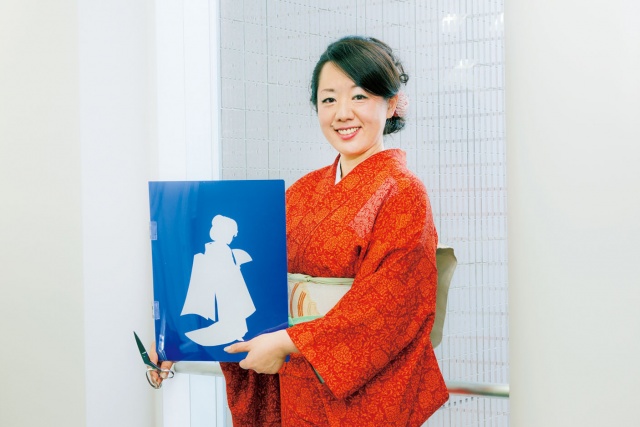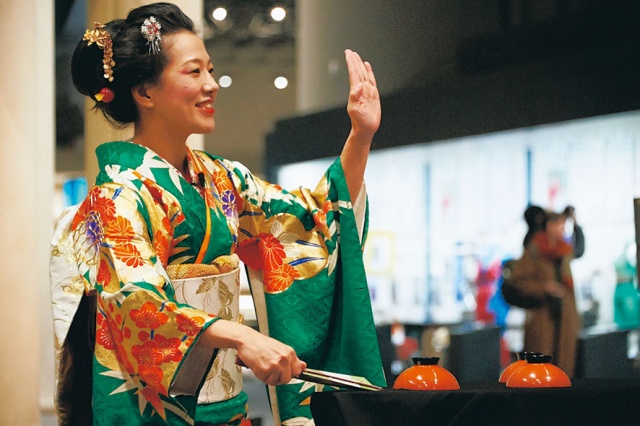vol.
012
MARCH
2016
vol.012 / Recommended information
Arts Council Tokyo Programs You Can't Miss This Spring!
INTERVIEW Hana Hayashiya(Traditional Culture and Performing Arts Program for Foreigners)|Performance Kids Tokyo|TACT/FESTIVAL 2016|INFORMATION
INTERVIEW
Hana Hayashiya Kamikiri (paper cutting) instructor, Traditional Culture and Performing Arts Program for Foreigners
Everyone can enjoy this traditional performing art, which transcends nationality

Communication through kamikiri (paper cutting)
Kamikiri is a traditional performing art; one theory says kamikiri originated in the Edo era, in which a performer talks to the audience while cutting silhouettes of various subjects such as animals or lucky charms from a single piece of paper. We kamikiri artists perform it at traditional Japanese variety halls, parties and so on. In this program, foreigners will have a chance to try the art of Japanese paper cutting themselves. If you’ve ever used a pair of scissors, you can enjoy kamikiri even if you’re a complete beginner. That’s one of the beauties of kamikiri.
At the start of each program I demonstrate kamikiri by cutting out a silhouette of a maiko (apprentice geisha). Then the participants choose what they like from a choice of simple subjects such as a baby chick, a rabbit or a turtle, and try kamakiri themselves. People from various regions including Asia, North America and Europe have participated in the program. Seeing both children and grownups become completely absorbed in making kamakiri cutouts makes me happy, too.
What I aim for in lectures is to converse without an interpreter as much as possible. I’m still studying English and have a long way to go, but even if my English is poor, I can communicate my feelings better when I speak to people directly — and it seems to me that the participants are happy when I do. In kamikiri we don’t use paper patterns or make preliminary sketches, so the finished shape shows the individual’s personality. We talk and laugh as we show each other our artwork. Kamakiri gives rise to communication transcending nationality — that’s a great thing, don’t you think? For me, too, it is really fun to have this kind of exchange with a wide variety of people.
It seems to me that globalization is moving forward in the lead-up to the Tokyo 2020 Olympic and Paralympic Games. Recently, in performances held at parties, for example, I notice more visitors from other countries than before. I think there will probably be more and more chances to transmit kamikiri art for people in Japan and overseas.
Currently there are only about five kamikiri artists in Japan who perform at traditional variety halls. And I’m the only woman. This traditional performing art has been handed down with great respect and care, and I would like to make it known to as many people as possible. To do that, I want to make the best use of a distinctively feminine sensibility, and keep refining my kamikiri technique and conversation skills, as well as my English skills.
Hana Hayashiya
Kamikiri artist. She began studying with Imamaru Hayashiya in 1995. After completing her training as a zenza (opening act) performer, she began performing on the main stage in the September 2008 mid-month performance slate. Hayashiya is a member of the Rakugo Geijyutsu Association, and the first and only female kamikiri artist in the history of yose (traditional variety halls).
Traditional Culture and Performing Arts Experience Program for Foreigners
We are organizing accessible programs that offer foreigners the opportunity to enjoy authentic traditional Japanese culture and performing arts. The programs are free of charge and include English explanations. “Engei Vaudeville Performance Workshop,” “Traditional Japanese Dance Workshop” and “Shamisen of Nagauta Workshop” will be held until the end of March. For information on programs held from April on, please see the official website (www.tokyo-tradition.jp/eng).
Engei Vaudeville Performance Workshop
Watch professionals demonstrate their skills in ever-popular Japanese performance arts such as kamikiri (paper cutting), kyokugei (umbrella-spinning, etc.), and wazuma (traditional Japanese magic), and try them yourself!
Date/ Every Saturday until March 2016
Venue/ Edo−Tokyo Museum
Traditional Japanese Dance Workshop
After putting on a cotton yukata and trying out some simple Nihon buyo (traditional Japanese dance) movements, you will have a chance to watch part of the traditional dance “Fuji Musume (Wisteria Maiden).” At the end, you can take photographs with the instructors.
Date/ Every Sunday until March 2016 (Excluding March 13, 2016)
Venue/ Asakusa Culture Tourist Information Center
Shamisen of Nagauta Workshop
Nagauta originated as Kabuki music and developed as shamisen music. In this program you can try playing the shamisen yourself, as you get to know Nagauta through performances and explanations by professional Nagauta players.
Date/ 3.12 (Sat) – 3.13 (Sun), 2016
Venue/ Asakusa Culture Tourist Information Center

Photo: Jouji Suzuki
Editing & Written by Rina Hirabayashi / Playce
Translation: Office Miyazaki, Inc.



